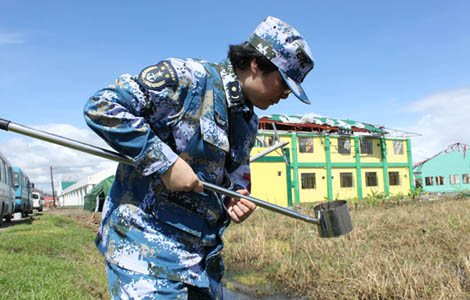Vast deposits of 'flammable ice' found
Updated: 2013-12-18 00:43
By Wang Qian (China Daily)
|
|||||||||||
A research team has found China's most promising natural gas hydrate deposits under the Pearl River, improving chances the icelike formations will ease the country's energy shortages, scientists said on Tuesday.
The discovery showed about 150 billion cubic meters of natural gas hydrates, also called "flammable ice", exist in an area of 55 square kilometers under the eastern Pearl River.
"It is very encouraging to have such a huge source of untapped energy discovered," said Zhang Xueguang, chief scientist of the Guangzhou Marine Geological Survey, which is hosting the research, at a news conference in Beijing on Tuesday.
Statistics released by the Beijing Gas Group Co Ltd show the capital used 8.4 billion cu m of natural gas in 2012, meaning the new discovery could supply the capital's natural gas for nearly 18 years at that same rate.
Flammable ice is almost pure methane mixed with water and frozen under high pressure in permafrost or under the sea.
One cu m of natural gas hydrate can release at least 164 cu m of methane, and is considered a potential green energy resource.
Despite such energy potential, no country has yet been able to utilize the resource commercially due to the challenging conditions of the flammable ice and unpredictable effect on the environment.
"China is speeding up its pace in natural gas hydrate exploration and utilization," said Che Changbo, deputy director of the geological exploration department under the Ministry of Land and Resources.
"Commercial production of the resource will begin in China's tundra around 2020, and underwater around 2030," Che said, adding commercial production will help ease the country's dependence on oil and coal.
Besides China, many countries, including Canada, Japan, US and Norway, are accelerating preparation for commercial production of natural gas hydrates.
A Japanese energy company announced in February it had extracted natural gas from offshore flammable ice deposits, becoming the first in the world to do so, and expected to achieve commercial production within six years.
"It means commercial production of flammable ice is feasible," said Zhang Haiqi, chief scientist with the China Geological Survey.
Scientists say natural gas hydrates exist under hundreds of meters of sedimentary stone under the sea or in tundra, from about 200 to 2,000 meters underground.
Promising reserves of the resource have been detected at the bottom of many of the world's seas and oceans, including the South China Sea, the Arctic Ocean, the Indian Ocean, and waters surrounding Antarctica and Australia.
China started flammable ice research in 1995 and the country collected its first natural gas hydrate samples in the South China Sea in 2007, making China the fourth country to confirm such underwater findings, after the United States, Japan and India.
Related Stories
The huge potential of 'flammable ice' as a new source of energy 2013-09-29 07:26
Today's Top News
Monaco and Shanghai jointly to grow yachting biz
Vast deposits of 'flammable ice' found
System for organ donors test
Hukou reforms target 2020: official
Russia to bail out Ukraine for $15 billion
Merkel sworn in for a third term
Japan seeks bigger role for military
US budget deal clears crucial vote
Hot Topics
Lunar probe , China growth forecasts, Emission rules get tougher, China seen through 'colored lens', International board,
Editor's Picks

|

|

|

|

|

|





